
NGC 1058 is a Seyfert Type 2 galaxy in the NGC 1023 Group, located in the Perseus constellation. It is approximately 27.4 million light years from Earth and has an apparent magnitude of 11.82. It is receding from Earth at 518 kilometers per second (322 mi/s), and at 629 kilometers per second (391 mi/s) relative to the Milky Way.

NGC 935 and IC 1801 are a pair of interacting galaxies within the Aries constellation. They were discovered on 18 September 1885 by Lewis Swift. NGC 935 is the northern member of the pair, and IC 1801 is the southern. Together, they are listed in Halton Arp's Atlas of Peculiar Galaxies as Arp 276, as an example of interacting galaxies.
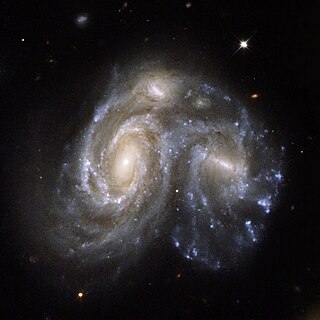
Arp 272 is a pair of interacting galaxies consisting of the two spiral galaxies NGC 6050 (left) and IC 1179 (right). Arp 272 lies around 450 million light years from Earth in the constellation of Hercules. The galaxies are part of the Hercules Cluster, which is itself part of the CfA2 Great Wall.

NGC 296 is a low surface brightness unbarred spiral galaxy in the constellation of Pisces. The designation NGC 295 is sometimes mistakenly used for NGC 296.

NGC 4697 is an elliptical galaxy some 40 to 50 million light-years away in the constellation Virgo. It is a member of the NGC 4697 Group, a group of galaxies also containing NGC 4731 and several generally much smaller galaxies. This group is about 55 million light-years away; it is one of the many Virgo II Groups, which form a southern extension of the Virgo Supercluster of galaxies.
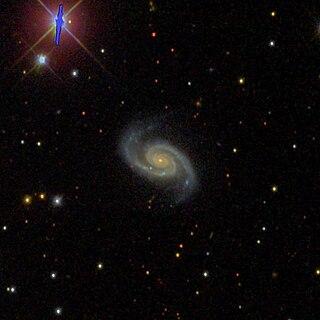
NGC 6560 is a spiral galaxy located in the constellation Hercules. It was discovered by Lewis A. Swift on 22 October 1886.

NGC 5559 is a barred spiral galaxy, located 240 million light-years away in the constellation of Boötes. It was discovered on April 10, 1785, by the astronomer William Herschel.
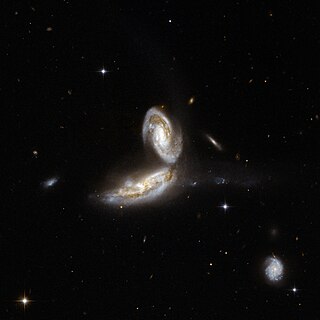
NGC 5331 is a pair of two interacting spiral galaxies in the constellation Virgo. They were discovered by William Herschel on May 13, 1793.

NGC 3705 is a barred spiral galaxy in the constellation Leo. It was discovered by William Herschel on Jan 18, 1784. It is a member of the Leo II Groups, a series of galaxies and galaxy clusters strung out from the right edge of the Virgo Supercluster.
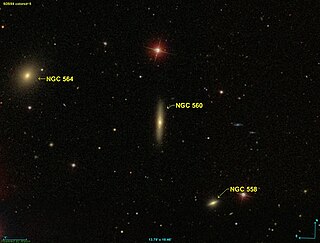
NGC 560 is a lenticular galaxy in the constellation Cetus. It is estimated to be about 250 million light-years from the Milky Way and has a diameter of approximately 150,000 light years. It is part of the Abell 194 galaxy cluster. NGC 560 was discovered on October 1, 1785 by the German-British astronomer William Herschel.
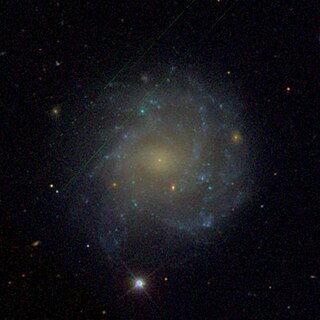
NGC 991 is an intermediate spiral galaxy the constellation Cetus. This galaxy was discovered by astronomer William Herschel in 1785.

NGC 5004 is a lenticular galaxy in the constellation Coma Berenices. The object was discovered by astronomer William Herschel in 1785, using an 18.7-inch aperture reflector telescope. Due to its moderate apparent magnitude (+13), it is visible only with amateur telescopes or with superior equipment.

NGC 662 is a spiral galaxy in the constellation of Andromeda. Its velocity with respect to the cosmic microwave background is 5,397 ± 18 km/s, which corresponds to a Hubble distance of 79.6 ± 5.6 Mpc. It was discovered by French astronomer Édouard Stephan on 22 November 1884.

NGC 7171 is a barred spiral galaxy in the constellation of Aquarius. Its velocity with respect to the cosmic microwave background is 2388 ± 24 km/s, which corresponds to a Hubble distance of 35.22 ± 2.49 Mpc. It was discovered by German–British astronomer William Herschel on 12 August 1787.

NGC 828 is a spiral galaxy in the constellation of Andromeda. Its velocity with respect to the cosmic microwave background is 5118 ± 17 km/s, which corresponds to a Hubble distance of 75.49 ± 5.29 Mpc. It was discovered by German-British astronomer William Herschel on 18 October 1786.

NGC 2528 is an intermediate spiral galaxy in the constellation of Lynx. Its velocity with respect to the cosmic microwave background is 4098 ± 12 km/s, which corresponds to a Hubble distance of 60.45 ± 4.23 Mpc. It was discovered by French astronomer Édouard Stephan on 22 January 1877.

NGC 5260 is a barred spiral galaxy in the constellation of Hydra. Its velocity with respect to the cosmic microwave background is 6789 ± 21 km/s, which corresponds to a Hubble distance of 100.13 ± 7.02 Mpc. It was discovered by American astronomer Lewis Swift on 6 April 1885.

NGC 2804 is a lenticular galaxy in the constellation of Cancer. Its velocity with respect to the cosmic microwave background is 8580 ± 20 km/s, which corresponds to a Hubble distance of 126.55 ± 8.86 Mpc. It was discovered by British astronomer John Herschel on 24 February 1827. This galaxy was also observed by the French astronomer Stéphane Javelle on 9 April 1896, and was later added to the Index Catalogue as IC 2455.
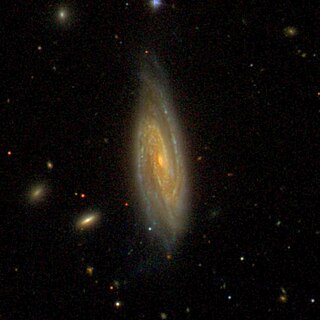
NGC 958 is a barred spiral galaxy in the constellation of Cetus. Its velocity with respect to the cosmic microwave background is 5505 ± 17 km/s, which corresponds to a Hubble distance of 81.20 ± 5.69 Mpc. However, 19 non-redshift measurements give a distance of 58.93 ± 12.91 Mpc. The galaxy was discovered by German-British astronomer William Herschel on 20 September 1784.

NGC 3914 is a barred spiral galaxy in the constellation of Virgo. Its velocity with respect to the cosmic microwave background is 6466 ± 25 km/s, which corresponds to a Hubble distance of 95.38 ± 6.69 Mpc. However, six non-redshift measurements give a distance of 81.2 ± 2.8 Mpc. The galaxy was discovered by German-British astronomer William Herschel on 13 April 1784.




















